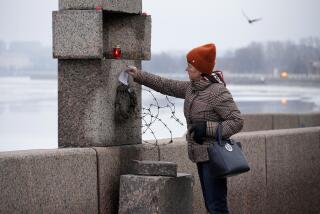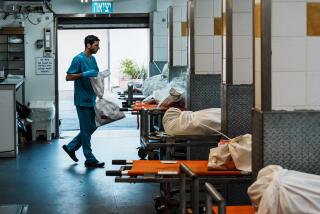Syria activists look to a grave for evidence against Assad
WASHINGTON — The hunt for proof that Syrian government forces used banned chemical weapons may come down to a rotting corpse exhumed late last month from a makeshift cemetery near Damascus.
The grave diggers — a Syrian doctor and several medical students — were seeking tissue from the remains of a man who had died of respiratory failure after a rocket allegedly spewed poison gas on Dariya, a suburb of the Syrian capital, on April 25.
Reaching the cadaver several feet down, the team sliced open the cloth shroud, cut into the torso and removed a small piece of lung. They also took an eyeball, a lock of hair and bits of clothing, according to two fellow Syrian opposition activists who helped arrange the graveside dissection.
It was more than a week before the samples — sealed in small plastic containers and initially kept on ice — were slipped out of Syria by opposition operatives and handed to officials at the U.S. Embassy in Beirut for testing.
The macabre story shows how hard the Syrian opposition is working to prove its contention that President Bashar Assad’s government has used poison gas against rebels. President Obama warned Syria last year that use of lethal chemical agents or their transfer to terrorists would cross a “red line” and prompt a still-unspecified U.S. response.
The episode also helps explain why the Obama administration is concerned about the “chain of custody” of samples emerging from Syria, worried that chemical-laced tissue, soil and other materials may have been faked, contaminated or spoiled by heat and time.
Last month, the White House acknowledged in a letter to Congress, even before the corpse in Dariya was exhumed, that it had received “physiological samples” that led U.S. intelligence agencies to conclude “with varying degrees of confidence” that Assad had used sarin nerve gas “on a small scale.” It did not say how the samples were obtained.
The Dariya graveyard mission was organized by the Syrian Support Group, an exile organization with offices in Turkey and Washington. It has implored the United States and its allies to intervene in the two-year Syrian civil war, and opposition activists hope that providing proof of illicit weapons use may be enough to force a reluctant international community to act.
“We and the people on the ground are ready to do anything, including digging up graves, in order for the world to know the truth about these attacks, so they will change their stance,” said one of the activists, who requested anonymity to protect their safety.
On Friday, the Syrian Support Group and other opposition forces publicized new reports alleging that Assad’s forces the night before had used poison gas in Adra, on the outskirts of Damascus.
One group, citing sources in Syria, said in a statement that the attack killed four people and sickened 50, “some with suffocation and others with fatigue accompanied by a severe allergic reaction.” The report, and previous reports like it, could not be confirmed.
The fog of war seems especially dense when it comes to determining whether illicit chemical attacks have occurred in Syria — and if so, which side was responsible.
Experts say it’s possible that some combatants have used tear gas or other crowd-control agents that are not banned. It’s also possible that government or insurgent forces have shelled pesticide or chemical factories and accidentally released clouds of lethal or incapacitating toxic mist.
They note that none of the alleged attacks have produced mass casualties consistent with a major nerve or mustard gas attack.
Robert Serry, the United Nations Middle East peace envoy, warned the U.N. Security Council this month of “mounting reports on the use of chemical weapons” in Syria. He called on Assad to allow a team of U.N. inspectors into the country to investigate the allegations.
The U.S. so far has provided humanitarian and other nonmilitary aid to the rebels, resisting calls to get more directly involved in a conflict that U.N. officials say has killed more than 80,000 people.
American confidence about chemical warfare evidence varies because the “chain of custody is not clear,” said Bernadette Meehan, a spokeswoman for the White House National Security Council. “That is why we are working with the Syrian opposition, friends and allies to share and evaluate information associated with reports of the use of chemical weapons.”
The Dariya operation was the Syrian Support Group’s second attempt to put evidence into the hands of a foreign government.
In March, it enlisted supporters to collect hair and urine samples from victims, plus soil and other material, after an alleged chemical attack killed 25 people and wounded dozens in Khan al Asal, near the northern city of Aleppo.
The samples were smuggled across the border to Turkey and handed to a British government representative, according to the two Syrians who also described the Dariya incident.
Less than a month later, Britain and France sent a joint letter to U.N. Secretary General Ban Ki-moon asserting that soil samples, witness interviews and opposition sources supported charges that lethal nerve agents had been used in and around Aleppo, Homs and possibly Damascus.
A British official declined to say whether the evidence cited in the letter included the Khan al Asal samples.
Getting the eyeball and other material from the corpse in Dariya to U.S. government officials was considerably more difficult.
The town of 75,000 people has seen intense fighting and heavy casualties since the start of the revolt against Assad in 2011, and control has seesawed between the government and rebel forces.
When Syrian troops attacked residential areas in the southern part of Dariya on April 25, opposition activists say, the government used some form of gas.
The Syrian Support Group said doctors in Dariya reported that rockets produced toxic clouds at 1 a.m. and again at 7 a.m. The opposition group said more than 100 residents sought medical care for muscle spasms, bronchial spasms, headaches, dizziness and vomiting.
The body was dug up two days after it was buried. The unofficial autopsy was watched over by a local cleric, who had given his blessing for the body to be exhumed despite strict Islamic rules against defiling the dead, and by the local rebel commander, who gave his approval.
The original plan called for a courier to carry the samples by car from Damascus south to Jordan. But after driving 50 miles, he ran into a battle between government forces and rebels, and was forced to turn back.
A refugee family fleeing fighting around Damascus agreed to smuggle the material into Lebanon. To pass Syrian military checkpoints, the containers were sewn into the family members’ clothes.
They were “unaware that they were carrying samples of chemical attacks,” said one of the activists, but they knew the material could put them in danger if they were caught.
After the family crossed the border, they wrapped the containers in a plastic bag and buried them in a prearranged dead drop under a tree on a hill outside a market town in southern Lebanon.
A Syrian Support Group member asked a friend in the northern Lebanese city of Tripoli to drive down, dig up the material and take it to Beirut. It took another week for the group’s activists in Washington and Turkey to arrange for the tissue to be picked up by a U.S. Embassy official in Beirut.
American officials had “a lot of questions about the authenticity” of the samples, one of the activists said. Since getting the samples, U.S. officials have not told the group whether tests revealed residue of chemical agents.
Asked by The Times, officials at the CIA and State Department refused to say whether they had received the Dariya material, or whether it had tested positive for lethal chemicals.
Members of the opposition group bristle at suggestions that they are trying to manipulate evidence to draw the United States into Syria’s civil war. They said even they don’t know whether the corpse contained traces of chemical agents.
“Our role was to get the samples to the proper hands,” said Dan Layman, a Syrian Support Group spokesman. “I trust that those results, if confirmed positive, will be reflected in policy changes or deliberations on how to curb such threats in Syria going forward.”
More to Read
Sign up for Essential California
The most important California stories and recommendations in your inbox every morning.
You may occasionally receive promotional content from the Los Angeles Times.











